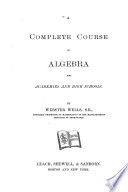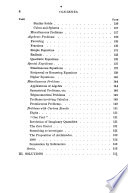 | Popular educator - 1884 - 910 pages
...— = aa aaa aaaaa If a + Ъ be multiplied into о — b, the product will bo a*— Tf ; that is — The product of the sum and difference of two quantities is equal to the difference of their squares. This is an instance of the facility with which general truths are demonstrated in algebra. If the sum... | |
 | Webster Wells - Algebra - 1885 - 324 pages
...plus the square of the second. In the third case, we have (a + b) (a — b) = a2 — b-. (3) That is, the product of the sum and difference of two quantities is equal to the difference of their squares. EXAMPLES. 96. 1. Square 3а +2bc. The square of the first term is 9 a2, twice the product of the terms... | |
 | Webster Wells - Algebra - 1885 - 370 pages
...plus the square of the second. In the third case, we have (a -\-b)(a — b) = a2 — 62. (3) That is, the product of the sum and difference of two quantities is equal to the difference of their squares. EXAMPLES. 96. 1 . Square 3 a + 2 be. The square of the first term is 9 a2, twice the product of the... | |
 | Webster Wells - 1885 - 368 pages
...plus the square of the second. In the third case, we have (a + b) (a — 6) = a2 — b2. (3) That is, the product of the sum and difference of two quantities is equal to the difference of their squares. EXAMPLES. 96. 1. Square 3 a + 2 be. The square of the first term is 9 a2, twice the product of the... | |
 | John Bernard Clarke - Algebra - 1889 - 566 pages
...~product is made up as stated in the proposition. — mn 4- »* m 2 — 2m» 4- " 2 71. Theorem.—The product of the sum and difference of two quantities is equal to the difference of their squares. If a and 6 represent the quantities, show by direct multiplication that (a + b) (a—6) = o« — b... | |
 | Walter William Rouse Ball - Mathematics - 1890 - 512 pages
...product of x + a and x — a. x +a x—a We see, from this example, that the product of the sum aud the difference of two quantities is equal to the difference of their squares. Thus, 98 x 102 = (100 -2) (100 + 2) = 10000 -4 = 9996. Esc. 4. Find the product of x + a and x+b. x... | |
 | John Kelley Ellwood - Algebra - 1892 - 300 pages
...first, plus the square of the second, minus twice the product of the two, or d' = A2 + Б2 — 2 p. The product of the sum and difference of two quantities is equal to the difference of their squares, or sd = A2 — B*. The chord of an angle is equal to twice the sine of half the angle. 18. Area of... | |
 | Asa Hollister Craig - Examinations - 1897 - 538 pages
...however, the binomial be a residual the sign of the second term in the square should be minus. 41. The product of the sum and difference of two quantities is equal to the difference of their squares. 42. If the signs of terms are alike, prefix the plus sign to the quotient; if they are unlike, prefix... | |
 | Joseph Ray - Algebra - 1894 - 252 pages
...a-|- 6 represents the sum of two quantities, and a — b, their difference. Hence, Theorem III. — The product of the sum and difference of two quantities is equal to the difference of their squares. 1. (5+3)(5— 3)=25— 9=16=8x2. 2. (2a+6)(2a— 6)=4a2— V. 3. (2x+3y](2x—3y)^4iif—9y\ 4. (5a+46)(5a—... | |
 | William James Milne - Algebra - 1894 - 216 pages
...difference of two quantities obtained from the quantities ? 2. What sign connects the terms ? 63. PRINCIPLE. The product of the sum and difference of two quantities is equal to the difference of their squares. Write the products of the following : 2. (m + гг) (та — n). 4. (2 a + b) (2 a -b). 5. (2 x +... | |
| |